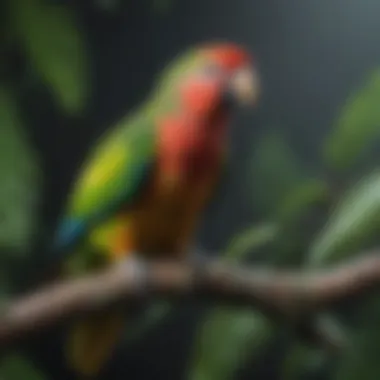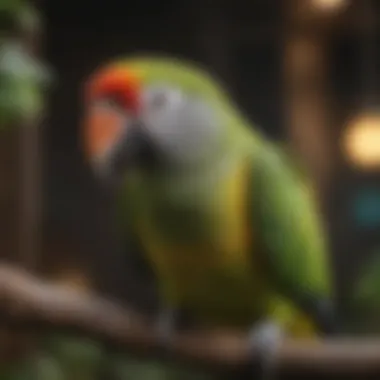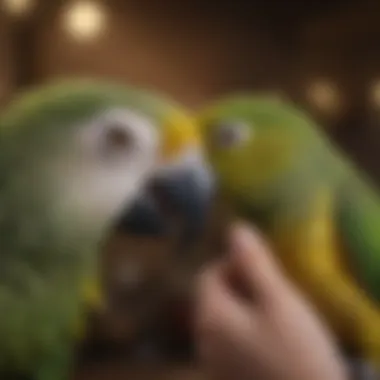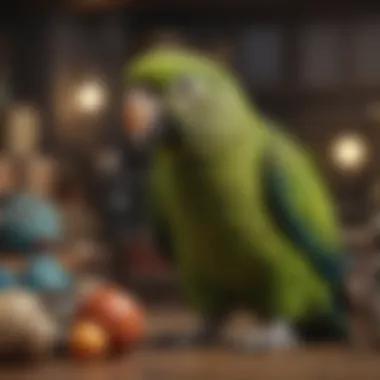Exploring Amazon Parrot Breeds: Traits and Care


Intro
Amazon parrots, known for their lively personalities and vibrant plumage, have captivated bird enthusiasts for centuries. This comprehensive guide aims to unveil the intricate details surrounding various Amazon parrot breeds. Understanding their unique traits, care needs, and behavioral characteristics is crucial for current and potential pet owners. Purchasing an Amazon parrot is not merely a decision; it is a commitment requiring substantial knowledge. This guide provides insights that can aid in making informed choices about these intelligent, social creatures.
Understanding Your Pet
Pet Behavior Basics
Amazon parrots are highly social and intelligent, often forming strong bonds with their human counterparts. Their vocalizations can range from sweet whistles to loud calls, reflecting their mood and environment. These birds require consistent interaction and mental stimulation to prevent boredom and behavioral issues. Recognizing their body language can be helpful.
Common Breed Characteristics
Different Amazon parrot breeds share some characteristics but also have distinctive traits. Common traits include:
- Vocal Ability: Many Amazons are excellent mimics, often learning a variety of sounds and phrases.
- Active Nature: These parrots are generally lively and need room to move and explore.
- Playfulness: They enjoy games, toys, and human interaction.
Notable breeds include:
- Yellow-naped Amazon
- Blue-fronted Amazon
- Double Yellow-headed Amazon
Species-Specific Needs
While all Amazon parrots need interaction and mental stimulation, certain breeds have specific care requirements. For example, a Yellow-naped Amazon may require more social interaction due to its affectionate nature, while a Blue-fronted Amazon might thrive with a variety of toys to explore.
Pet Care and Maintenance
Feeding Guidelines
Proper nutrition is vital for your Amazon parrot's health. A balanced diet should include:
- High-quality pellets
- Fresh fruits and vegetables
- Occasional nuts and seeds for treats
Avoid feeding them avocado, chocolate, or caffeine as these can be toxic.
Grooming Essentials
Regular grooming is important to maintain your parrot's health and appearance. Key aspects include:
- Wing trimming: Done periodically to prevent them from flying away.
- Nail trimming: Keeping nails at a manageable length is key.
- Bathing: Amazon parrots enjoy bathing, either in a shallow dish or with a gentle spray.
Hygiene Practices
Maintaining cleanliness in your parrot's environment is essential. Ensure to:
- Clean the cage daily.
- Change food and water regularly.
- Disinfect toys and perches occasionally.
Training and Development
Basic Commands and Skills
Starting with basic commands will help establish a good relationship with your parrot. Useful commands include:
Understanding Amazon Parrots
Understanding Amazon parrots is vital for anyone considering these birds as pets. It encompasses their unique traits, behaviors, and the requirements for their care. These aspects are crucial in making informed decisions about ownership.
Definition and Classification
Amazon parrots belong to the family Psittacidae, known for their lively personality and remarkable intelligence. They are predominantly tropical birds, with many species originating from Central and South America. The name 'Amazon' comes from their primary habitats found near the Amazon River basin. Classification of Amazon parrots includes several well-known species, such as the Yellow-Naped and Blue-Fronted Amazons. These classifications help potential owners understand the specific traits and needs of each breed, ensuring better care and companionship.
Historical Context


Historically, Amazon parrots have been integral to indigenous cultures in their native regions. They were often revered as symbols of wisdom and communication due to their ability to mimic human speech. Documented interactions between humans and these birds date back centuries. Birds like the Yellow-Naped Amazon have been part of local folklore and customs. In modern times, their popularity as pets surged in the late 20th century, largely due to their charming behaviors and stunning appearances. This historical context, tied to their intelligence and social nature, frames the ongoing relationship between humans and Amazon parrots today.
Key Characteristics of Amazon Parrots
Understanding the key characteristics of Amazon parrots is crucial for potential owners and enthusiasts alike. These attributes not only define their unique personalities, but also guide care and socialization. Having a thorough grasp on these traits helps in making informed choices regarding keeping Amazon parrots as pets.
Physical Attributes
The physical attributes of Amazon parrots are striking and varied. They generally feature robust bodies, medium to large sizes, and vibrant plumage that attracts attention. Most species exhibit a range of colors, including greens, yellows, and blues, often with unique markings. This colorful appearance is not only aesthetically pleasing but also indicative of their health and well-being.
One notable aspect is their beak. The beak is strong and curved, designed for cracking open seeds and nuts. The feet, zygodactyl in nature, allow for gripping and climbing. These features aid in their adaptability within their natural habitats and emphasize their potential as interactive pets.
Additionally, the wingspan of Amazon parrots contributes to their ability to fly gracefully, providing exercise and mental stimulation. Owners should recognize the importance of these traits, as they influence the bird's overall health and happiness. A well-balanced diet and ample space for flight are essential considerations in their care.
Cognitive Abilities
Amazon parrots are recognized for their impressive cognitive abilities. These birds demonstrate intelligence that rivals that of some mammals. Many owners report their capacity for learning tricks, mimicking human speech, and solving simple problems. This intelligence necessitates mental stimulation and interaction to prevent boredom and behavioral problems.
Training is a vital part of maintaining a healthy environment for these birds. They respond well to positive reinforcement techniques, showcasing their eagerness to learn and interact. Owners can leverage this cognitive skill set for enrichment through puzzles, toys, and social interaction.
Furthermore, Amazon parrots display strong social skills. They thrive in environments where they can engage with their human companions or other birds. This engagement fosters better mental health and encourages emotional bonding. Without sufficient mental and social stimulation, these parrots may display unwanted behaviors.
In summary, understanding the physical characteristics and cognitive abilities of Amazon parrots lays the groundwork for effective care and nurturing.
These key traits underline the importance of thoughtful consideration when choosing to welcome an Amazon parrot into one’s life.
Major Amazon Parrot Breeds
The diversity of Amazon parrot breeds reflects a rich spectrum of traits and characteristics that potential owners must consider. Each breed holds unique qualities that may suit different lifestyles and preferences. Understanding these breeds is crucial for making an informed decision on which parrot can become a part of your family. The insights into their origins, social behaviors, care requirements, and temperaments provide a comprehensive framework for prospective owners.
Yellow-Naped Amazon
Origin
The Yellow-Naped Amazon is originally from Central America, primarily found in countries like Nicaragua and Honduras. This geographical background contributes to its adaptability and resilience. The connection to its native habitat helps in understanding its needs and behavior in a domestic setting. The rich history of this breed is a reason for its popularity among parrot enthusiasts, as it combines beauty with intelligence.
Social Behavior
Yellow-Naped Amazons are known for their playful and sociable nature. They thrive on interaction with their humans, creating strong bonds. This breed is a lively companion and can adapt well to a family environment. This characteristic makes them a favored choice for many parrot lovers. However, their lively disposition also means that they need constant stimulation, so owners should be prepared for engaging playtime.
Care Requirements
Caring for a Yellow-Naped Amazon requires attention to diet, social interaction, and living conditions. A varied diet that includes fresh fruits, vegetables, and high-quality pellets is essential. Additionally, they require a spacious cage and opportunities for social interaction. While they are low-maintenance compared to some breeds, the requirement of consistent companionship is significant. This can be a con for those who work long hours.
Double Yellow-Headed Amazon
Physical Traits
The Double Yellow-Headed Amazon stands out due to its remarkable appearance. It features a striking yellow head, green body, and a rather distinctive shape. This breed is often appreciated for its beauty, making it a popular choice for bird enthusiasts. The prominent colors and size make them visually appealing as well as captivating companions.
Temperament
Known for their outgoing temperament, Double Yellow-Headed Amazons are friendly and playful. This breed tends to be very affectionate and enjoys socializing. Such temperament helps them integrate well into home environments. However, this affection can sometimes turn into demanding behavior if not managed properly. Owners need to establish boundaries to ensure a balanced relationship.
Training Needs
Training requirements for the Double Yellow-Headed Amazon can vary depending on their age and previous experiences. Early training is beneficial and includes teaching basic commands and social cues. Their intelligence allows them to learn quickly; however, consistent training is the key to success. This characteristic enhances the bond with the owner but requires time commitment.
Blue-Fronted Amazon
Habitat
The Blue-Fronted Amazon originally inhabits the forests and woodlands of Brazil and surrounding areas. This habitat impacts their behavior and comfort in captivity. It is essential for owners to create an environment that mimics their natural surroundings. Providing space to fly, along with natural perches, can significantly benefit their well-being.


Health Considerations
Health monitoring for Blue-Fronted Amazons necessitates regular veterinary check-ups. Such visits help in catching potential illnesses early. This species is generally hardy, but issues like obesity and feather plucking can occur without proper care. This aspect emphasizes the importance of understanding health management when considering this breed.
Dietary Needs
A balanced diet is crucial for the Blue-Fronted Amazon. It requires a mix of commercial pellets, seeds, and fresh produce. Most notably, vitamin-rich foods like dark leafy greens and fruits play a significant role in their nutrition. Not meeting dietary needs can lead to health issues, so understanding their specific requirements is critical for owners.
Orange-Winged Amazon
Behavioral Traits
The Orange-Winged Amazon is famous for its robust and playful nature. They thrive on stimulation and tend to exhibit active behavior that keeps them engaged. This breed can be entertaining, making them excellent companions. However, they may also display boisterous behavior, which necessitates careful monitoring.
Breeding Information
Breeding Orange-Winged Amazons demands a well-planned approach. It is essential to research their reproductive habits and provide proper nesting environments. Owners contemplating breeding should prepare for the commitment involved. Understanding the breeding process can help ensure the wellbeing of both parents and chicks.
Compatibility with Other Pets
Orange-Winged Amazons can adapt to homes with other pets, but careful introductions are vital. Their sociable nature often makes them comfortable around other animals, provided they are introduced correctly. However, certain breeds may be too aggressive for this amiable parrot, which is a consideration for potential owners.
Lilac-Crowned Amazon
Distinct Features
The Lilac-Crowned Amazon possesses unique characteristics, including its distinctive lilac crown and vibrant green plumage. This aesthetic quality adds to its charm and appeal. These features make it a sought-after breed for those looking for a visually engaging pet. Their beauty cannot be understated, with the coloration offering a striking presence.
Vocalization Patterns
With a natural inclination to vocalize, Lilac-Crowned Amazons can be quite expressive. They can mimic sounds and develop their vocal abilities, often imitating household noises. This trait is appealing to some owners but can also become noisy, illustrating the importance of understanding their vocal nature.
Social Interaction
Social experiences are vital for a Lilac-Crowned Amazon's wellbeing. They need consistent interaction to prevent boredom, which can result in negative behaviors. Their affectionate nature fosters strong bonds with owners, but this requires active participation and engagement. Recognizing their social needs can enhance the quality of life for both the bird and owner.
Choosing the Right Amazon Parrot
Choosing the right Amazon parrot is crucial for both the potential owner and the bird itself. It is not merely about picking a colorful companion; it's a decision that impacts the quality of life for both parties. Amazon parrots are intelligent, social creatures, that thrive in environments where their needs are met systematically. Therefore, understanding the specific characteristics of each breed and aligning them with your lifestyle cannot be overstated.
Before acquiring an Amazon parrot, it is essential to consider various factors. Not all breeds of Amazon parrots have the same temperament, care requirements, and activity levels. When selecting a parrot, aligning your own lifestyle with the needs of the bird can lead to a more successful and fulfilling companionship.
Evaluating Lifestyle Considerations
When it comes to choosing an Amazon parrot, evaluating personal lifestyle is a critical starting point. This involves assessing your daily routine, family dynamics, space availability, and financial capacity to support a bird. Each Amazon parrot has unique needs that must be understood beforehand.
- Daily Time Commitment: Amazon parrots require social interaction. They thrive on engagement and can develop behavioral issues if neglected.
- Space Requirements: Birds need enough space to fly and play. A suitable cage and an area for supervised out-of-cage time are vital.
- Family Interaction: Consider who else is in your home. Some Amazon parrot breeds may be more compatible with children or other pets than others.
- Financial Considerations: Owning a parrot involves more than just the initial purchase price. Food, veterinary care, and supplies can be considerable ongoing costs.
In this context, it can be helpful to list your priorities and concerns. High levels of interaction may necessitate a more sociable breed, while tighter budgets might lead to alternative choices in care options.
Understanding Commitment Levels
Owning an Amazon parrot is a long-term commitment. It is not a transient hobby but rather a partnership that can span decades. This understanding is fundamental when contemplating bringing a parrot into your home.
- Lifespan Awareness: Amazon parrots can live for over 40 years. This longevity means preparing for their needs throughout your life.
- Behavioral Training: Training is ongoing. Establishing desired behaviors and avoiding problems requires regular effort.
- Health Management: Regular veterinary visits and health monitoring are necessary. Knowing how to recognize signs of illness is also crucial.
- Emotional Investment: Understanding that Amazon parrots are sensitive beings that require emotional attention is central to their well-being. They can exhibit signs of distress if not given adequate love and attention.
Choosing the right Amazon parrot means evaluating these commitment levels, ensuring you can fulfill them consistently. It may be prudent to establish a plan on how to integrate the parrot into your life.
Care and Maintenance
Proper care and maintenance are paramount for the health and well-being of Amazon parrots. These birds, known for their intelligence and social dynamics, require dedicated attention to thrive in a home environment. Understanding and implementing care routines enhances their longevity and quality of life. This section addresses crucial elements of feeding, housing, and health monitoring.
Feeding Guidelines


Nutrition is a vital aspect of care for Amazon parrots. A well-balanced diet promotes optimal health and supports their active lifestyles. To ensure proper nutrition, consider the following guidelines:
- Pelleted Diet: Commercial pellets formulated specifically for Amazon parrots should form the core of their diet. These pellets provide essential vitamins and minerals.
- Fresh Fruits and Vegetables: Incorporate a variety of fresh produce into their diet. Good options include apples, carrots, and leafy greens. Avoid avocado, as it is toxic to parrots.
- Seeds and Nuts in Moderation: While seeds and nuts can be offered, they should not dominate their diet. High-fat seeds can lead to obesity.
- Fresh Water: Ensure access to clean drinking water at all times. Change it daily to maintain freshness.
A well-balanced diet is fundamental. Proper nutrition directly affects behavior, plumage, and health.
Housing Requirements
Creating a suitable living environment is critical for Amazon parrots. They are active birds that need space to move and explore. When setting up their space, consider these factors:
- Cage Size: Choose a large cage that allows for ample movement. Minimum dimensions should be 24” x 24” x 36” to provide space for climbing and playing.
- Perches and Toys: Use natural wood perches of varying diameters to prevent foot problems. Include toys that promote physical and mental stimulation.
- Location: Place the cage in a room where the family spends time. Amazon parrots are social and benefit from interaction with their owners.
- Safety Measures: Ensure the environment is safe from hazards. Avoid placing the cage near toxic plants or substances.
Health Monitoring
Regular health monitoring is essential to catch any potential issues early. Amazon parrots can show subtle signs of illness, so attentive observation is necessary. Key components of health monitoring include:
- Routine Check-ups: Schedule annual veterinary visits with an avian specialist. These check-ups often include physical exams and diagnostic tests.
- Behavioral Observations: Watch for changes in behavior, such as decreased activity or changes in vocalization, which could signal health problems.
- Physical Health: Keep an eye on their feathers, eyes, and beak. Issues like feather plucking or changes in beak texture may indicate stress or health conditions.
- Weight Monitoring: Weigh your parrot regularly to check for healthy weight maintenance. Sudden weight loss or gain can be a sign of underlying issues.
Training and Socialization
Training and socialization are crucial aspects when it comes to caring for Amazon parrots. Understanding these elements can significantly impact the relationship between the bird and its owner. Owners who prioritize proper training foster a healthier, happier environment for their feathered companions. Effective training not only helps in managing behavior but also enhances the bird's ability to engage with its surroundings.
When considering training techniques, it is essential to recognize the unique behavioral traits inherent to Amazon parrots. These birds are intelligent and often require mental stimulation. Additionally, socialization plays a pivotal role in their development by shaping their interactions with both humans and other pets. Thus, focusing on these areas will yield benefits in terms of companionship and ease of care.
Effective Training Techniques
Applying the right training techniques can help Amazon parrots learn efficiently and form a strong bond with their owners. Some effective methods include:
- Positive reinforcement: This is a widely accepted technique. It involves providing rewards such as treats or praise when the parrot exhibits a desired behavior. This method encourages birds to repeat such behaviors in the future.
- Consistency: Training should be consistent across different sessions. Simple commands or cues should always elicit the same response to avoid confusion for the bird.
- Short sessions: Amazon parrots tend to have short attention spans. Keeping training sessions brief, ideally between five to ten minutes, can help maintain their engagement and effectiveness.
- Patience: Every bird learns at its own pace. It is crucial to be patient and not to force learning. Frustration can lead to stress for both the owner and the parrot.
Common Issues and Solutions
When considering Amazon parrots as pets, it is essential to be informed about common issues and solutions that may arise. Understanding these challenges enhances the overall experience of owning one of these intelligent birds. Proper knowledge equips potential owners with tools to handle various situations effectively. Addressing behavioral problems and health concerns proactively ensures a thriving relationship between the owner and their feathered companion.
Behavioral Problems
Amazon parrots, like many pets, may exhibit specific behavioral problems that require attention. Common issues include excessive noise, biting, and aggression. These behaviors can stem from a number of factors such as boredom, stress, or insufficient social interaction.
To address excessive noise, provide adequate stimulation through toys, playtime, and social interactions. An engaging environment helps minimize unwanted vocalizations as the bird remains mentally stimulated. Training techniques, such as positive reinforcement, are effective for redirecting biting and aggressive behaviors. Owners should remain patient, as consistency in training creates a better understanding of acceptable actions.
Additionally, establishing a routine can create a sense of security for the parrot. This predictability reduces anxiety and mitigates behavioral issues. Remember that these parrots thrive on interaction, so lack of engagement often leads to negative behaviors. Keep in mind that addressing behavioral problems can take time and patience.
It's vital to recognize that some behavioral problems can be manifestations of underlying health concerns, necessitating a comprehensive approach.
Health Concerns
The health of an Amazon parrot can pose challenges that require careful consideration. Common health concerns include obesity, feather plucking, and respiratory issues. Ensuring a well-balanced diet is crucial to prevent obesity, which can lead to other major health issues.
Adopting a suitable diet composed of seeds, vegetables, and fruits is fundamental. Regular veterinary check-ups can help monitor health and catch problems early. Regular blood tests can identify underlying issues before they escalate, enabling timely interventions.
Feather plucking is another concern often linked to stress or medical conditions. This issue necessitates a thorough evaluation by a professional avian veterinarian to determine the exact cause and appropriate treatment. Ensuring the bird has an enriching environment with appropriate toys can alleviate stress and reduce the likelihood of feather plucking.
Lastly, respiratory issues can arise from inadequate air quality or exposure to harmful substances like smoke or strong fumes. Maintaining a clean living environment is essential. Ensure that certain essential oils and common household cleaners are kept away from your bird to avoid any adverse effects. Proper ventilation and air quality management are key to preventing respiratory problems.
Epilogue
When contemplating the world of Amazon parrots, one must recognize the significance of concluding discussions around their care and characteristics. Understanding the nuances of each distinct breed not only enriches the knowledge of potential parrot owners, but also informs responsible ownership practices that can enhance the lives of both parrots and humans.
Final Thoughts on Amazon Parrots
Amazon parrots are fascinating companions who require both time and commitment. Their unique attributes, such as vibrant personalities and impressive intelligence, make them appealing pets. However, insights into their behaviors, care needs, and specific breed differences are crucial for prospective owners.
To summarize, here are some key elements to consider when thinking about adding an Amazon parrot to your home:
- Breed Knowledge: Each Amazon parrot breed brings its own set of characteristics and temperaments.
- Care Requirements: Proper feeding, housing, and health monitoring are essential for the well-being of these birds.
- Socialization and Training: Effective interaction and training techniques establish a strong bond between the parrot and owner.
Through this article, readers are equipped with the comprehensive information necessary to make informed decisions. Engaging with an Amazon parrot can be incredibly rewarding—however, it is vital to approach such a commitment with careful consideration and readiness to meet their needs.
Owning an Amazon parrot can be an enriching journey, fostering companionship and mutual understanding that transcends typical pet ownership.







